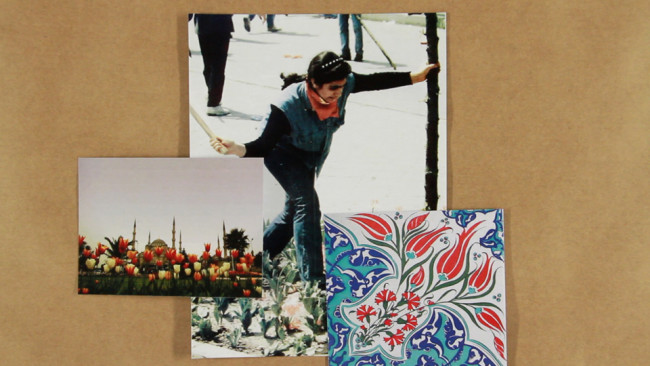20 November 2013
/ Acting Archives, Marathon
⟶
Stefanie Schulte Strathaus presents the history of the Arsenal Institute for Film and Video Art, its beginnings as an institution, and the need for such an institution in Berlin. Several issues are raised in discussion about the politics of maintaining a film archive, especially in relation to its own collection and to the city that houses it. Two projects are highlighted, The Living Archive and The Visionary Archive, collaborations that have resulted from projects with a number of practitioners and other archives from around the world.
Synthesis
Arsenal Institute for Film and Video Art • Berlin Film Festival • Archive of 10,000 films • The films in Arsenal’s archive have only one purpose: to be shown • Anthology Film Archives in New York • Expand...
Arsenal Institute for Film and Video Art • Berlin Film Festival • Archive of 10,000 films • The films in Arsenal’s archive have only one purpose: to be shown • Anthology Film Archives in New York • Started as association called Freunde der Deutsche Kinemathek • No alternative cinema in Germany in the 60s • An important aspect of Arsenal was the combination of film history with contemporary film practice • Lionel Rogosim – film Come Back Africa: the first film in the archive, the basis of the collection and the beginning of distribution • Michael Verhoeven – film OK • The start of the Forum of Young Cinema • International films first collected at the initiative of the festival to subtitle them • Films sent from countries under military dictatorships • What to do with old print vs. DVD? • Old prints get vinegar syndrome • Too costly to digitise everything • Films are not categorised in the collection • The Living Archive project • Many of the films exist only in this collection • Archive as a practice: archiving films, curating films, restoring films, showing films • Opening an archive is not threatening an archive • Avi Mograbi and Angela Melitopoulos in The Living Archive project • The Visionary Archive • Attempting to run an institution without being an institution • Erika and Ulrich Gregor are still part of Arsenal • Preserving the memory of the institution itself • The Living Archive attracted partners from other countries • Filmmaker Gadalla Gubara • Guinea Bissau and Egypt forming film archives • The Visionary Archive works with these emerging archives • Restoration also part of the institution’s work
Short biography
Stefanie Schulte Strathaus, film and video curator, co-director of the Arsenal Institute for Film and Video Art, member of the selection committee of the Berlinale Forum, Expand...
Stefanie Schulte Strathaus, film and video curator, co-director of the Arsenal Institute for Film and Video Art, member of the selection committee of the Berlinale Forum, and founding director of Forum Expanded, a section of the Berlin International Film Festival that negotiates the boundaries of cinema. Her curatorial work comprises numerous film programmes, retrospectives, and exhibitions, among them The Living Archive – Archive Work as a Contemporary Artistic and Curatorial Practice.
Stefanie Schulte Strathaus stellt die Geschichte des Arsenal – Institut für Film und Videokunst vor und spricht über die Notwendigkeit einer solchen Institution in Berlin. Die Diskussion berührt folgende Aspekte: die politischen Rahmenbedingungen für die Pflege eines Filmarchivs, die Bedeutung der eigenen Filmsammlung und die Rolle des Archivs für die Stadt Berlin. Zwei Projekte werden insbesondere erwähnt, The Living Archive und The Visionary Archive; beide involvieren Beteiligte und verschiedene andere Archive weltweit.
Synthese
Arsenal Institute for Film and Video Art • Berlinale • Archiv mit 10,000 Filmen • Die Filme im Archiv des Arsenal haben nur einen einzigen Zweck: Gezeigt zu werden • Anthology Film Archives in New York • Expand...
Arsenal Institute for Film and Video Art • Berlinale • Archiv mit 10,000 Filmen • Die Filme im Archiv des Arsenal haben nur einen einzigen Zweck: Gezeigt zu werden • Anthology Film Archives in New York • Entwickelte sich aus einem Verband namens Freunde der Deutsche Kinemathek • In den 1960er Jahren gab es kein alternatives Kino in Deutschland • Wichtiger Aspekt des Arsenal war die Kombination aus Filmgeschichte mit zeitgenössischen Filmpraktiken • Lionel Rogosim – Film Come Back Africa: Erster Film im Archiv, Grundlage der Sammlung und Ausgangspunkt des Vertriebs • Michael Verhoeven – Film OK • Beginn des Forum of Young Cinema • Internationale Filme wurden zuerst auf Initiative des Festivals gesammelt um sie mit Untertiteln zu versehen • Filme aus Ländern mit Militärzensur erhalten • Was tun mit alten Filmrollen vs. DVD? • Alte Filme bekommen Essig-Syndrom • Zu kostspielig alles zu digitalisieren • Filme in der Sammlung sind nicht kategorisiert • The Living Archive Projekt • Viele Filme existieren nur in der Sammlung • Archive als Praxis: Filme archivieren, kuratieren, restaurieren und zeigen • Ein Archiv eröffnen ist keine Bedrohung für Archive • Avi Mograbi und Angela Melitopoulos im The Living Archive Projekt • The Visionary Archive • Versuch eine Institution zu führen ohne eine Institution zu sein • Erika und Ulrich Gregor sind immer noch Teil des Arsenal • Das Andenken an die Einrichtung selbst erhalten • The Living Archive lockt Partner aus anderen Ländern an • Filmemacher Gadalla Gubara • Guinea Bissau und Ägypten begründen Filmarchive • The Visionary Archive arbeitet mit diesen entstehenden Archiven • Restauration ist auch Teil der Arbeit des Archivs
Kurzbiografie
Stefanie Schulte Strathaus, Film- und Videokuratorin, Co-Direktorin des Arsenal - Institut für Film- und Videokunst, Mitglied des Auswahlkommittees des Berlinale Forums Expand...
Stefanie Schulte Strathaus, Film- und Videokuratorin, Co-Direktorin des Arsenal - Institut für Film- und Videokunst, Mitglied des Auswahlkommittees des Berlinale Forums und Gründerin und Leiterin des Forum Expanded, einem Bereich des Berlin International Film Festivals, der die Grenzen des Kinos auslotet. Ihre kuratorische Arbeit umfasst zahlreiche Filmprogramme, Retrospektiven und Ausstellungen, unter anderem The Living Archive – Archive Work as a Contemporary Artistic and Curatorial Practice.
